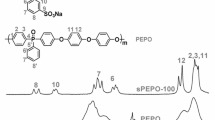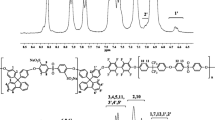Abstract
As a kind of high performance polymer, polybenzoxazoles are of interest as the matrix of proton exchange membrane (PEM). Soluble sulfonated polybenzoxazoles (sPBO) were synthesized by incorporation of the hexafluoroisopropylidene moieties into the polymer backbone, which show high molecular weight and excellent thermal stability. The hydrolytic stability of sPBO was investigated in detail in order to determine whether it is suitable for PEM applications or not. Contrary to expectation, sPBO membranes underwent hydrolysis under mild conditions. The hydrolysis of sPBO was confirmed by NMR, IR spectroscopy, and gel permeation chromatography. This work showed that sPBO membranes could not be used as PEM due to the poor hydrolytic stability.







Similar content being viewed by others
References
Jones DJ, Rozière J (2003) Non-fluorinated polymer materials for proton exchange membrane fuel cells. Annu Rev Mater Res 33:503
Savadogo O (2004) Emerging membranes for electrochemical systems Part II. High temperature composite membranes for polymer electrolyte fuel cell (PEFC) applications. J Power Sources 127:135
Kreuer KD (2001) On the development of proton conducting polymer membranes for hydrogen and methanol fuel cells. J Membrane Sci 185:29
Rikukawa M, Sanui K (2000) Proton-conducting polymer electrolyte membranes based on hydrocarbon polymers. Prog Polym Sci 25:1463
Kerres J (2006) Covalent-ionically cross-linked poly(etheretherketone)-basic polysulfone blend ionomer membranes. Fuel Cells 6:251
Li QF, He RH, Jensen JO, Bjerrum NJ (2003) Approaches and recent development of polymer electrolyte membranes for fuel cells operating above 100°C. Chem Mater 15:4896
Lee HS, Roy A, Lane O, Dunn S, McGrath JE (2008) Hydrophilic–hydrophobic multiblock copolymers based on poly(arylene ether sulfone) via low-temperature coupling reactions for proton exchange membrane fuel cells. Polymer 49:715
Wang Z, Ni HZ, Zhao CJ, Li XF, Zhang G, Shao K, Na H (2006) Influence of the hydroquinone with different pendant groups on physical and electrochemical behaviors of directly polymerized sulfonated poly(ether ether sulfone) copolymers for proton exchange membranes. J Membrane Sci 285:239
Nakabayashi K, Matsumoto K, Ueda M (2008) Synthesis and properties of sulfonated multiblock copoly(ether sulfone)s by a chain extender. J Polym Sci Part A: Polym Chem 46:3947
Matsumura S, Hlil AR, Lepiller C, Gaudet J, Guay D, Shi ZQ, Holdcroft S, Hay AS (2008) Ionomers for proton exchange membrane fuel cells with sulfonic acid groups on the end groups: novel branched poly(ether-ketone)s. Macromolecules 41:281
Liu BJ, Robertson GP, Kim DS, Guiver MD, Hu W, Jiang ZH (2007) Aromatic poly(ether ketone)s with pendant sulfonic acid phenyl groups prepared by a mild sulfonation method for proton exchange membranes. Macromolecules 40:1934
Bai ZW, Dang TD (2006) Direct synthesis of fully sulfonated polyarylenethioether sulfones as proton-conducting polymers for fuel cells. Macromol Rapid Commun 27:1271
Genies C, Mercier R, Sillion B, Cornet N, Gebel G, Pineri M (2001) Soluble sulfonated naphthalenic polyimides as materials for proton exchange membranes. Polymer 42:359
Miyatake K, Asano N, Watanabe M (2003) Synthesis and properties of novel sulfonated polyimides containing 1,5-naphthylene moieties. J Polym Sci Part A: Polym Chem 41:3901
Yin Y, Fang JH, Watari T, Tanaka K, Kita H, Okamoto K (2004) Synthesis and properties of highly sulfonated proton conducting polyimides from bis(3-sulfopropoxy)benzidine diamines. J Mater Chem 14:1062
Xiao GY, Sun GM, Yan DY, Zhu PF, Tao P (2002) Synthesis of sulfonated poly(phthalazinone ether sulfone)s by direct polymerization. Polymer 19:5335
Xiao GY, Sun GM, Yan DY (2002) Polyelectrolytes for fuel cells made of sulfonated poly (phthalazinone ether ketone)s. Macromol Rapid Commun 23:488
Chen YL, Meng YZ, Li XH, Hay AS (2005) Poly(phthalazinone ether ketone) ionomers synthesized via N–C coupling reaction for fuel cell applications. Macromolecules 38:10007
Zhu XL, Liang YF, Pan HY, Jian XG, Zhang YX (2008) Synthesis and properties of novel H-bonded composite membranes from sulfonated poly(phthalazinone ether)s for PEMFC. J Membrane Sci 312:59
Ma XH, Shen LP, Zhang CJ, Xiao GY, Yan DY, Sun GM (2008) Sulfonated poly(arylene thioether phosphine oxide)s copolymers for proton exchange membrane fuel cells. J Membrane Sci 310:303
Ma XH, Zhang CH, Xiao GY, Yan DY (2008) Synthesis and characterization of sulfonated poly(phthalazinone ether phosphine oxide)s by direct polycondensation for proton exchange membranes. J Polym Sci Part A: Polym Chem 46:1758
Asensio JA, Borros S, Gomez-Romero P (2002) Proton-conducting polymers based on benzimidazoles and sulfonated benzimidazoles. J Polym Sci Part A: Polym Chem 40:3703
Qing SB, Huang W, Yan DY (2005) Synthesis and characterization of thermally stable sulfonated polybenzimidazoles obtained from 3,3′-disulfonyl-4,4′-dicarboxyldiphenylsulfone. J Polym Sci Part A: Polym Chem 43:4363
Xiao LX, Zhang HF, Scanlon E, Ramanathan LS, Choe EW, Rogers D, Apple T, Benicewicz BC (2005) High-temperature polybenzimidazole fuel cell membranes via a sol–gel process. Chem Mater 17:5328
Jannasch P (2005) Fuel cell membrane materials by chemical grafting of aromatic main-chain polymers. Fuel Cells 5:248
Kim JD, Honma I (2005) Anhydrous solid state proton conductor based on benzimidazole/monododecyl phosphate molecular hybrids. Solid State Ionics 176:979
Yang HH (1989) Aromatic heterocyclic polymers. In: Aromatic high-strength fibers. Wiley, New York, pp 833–842
Arnold C (1979) Stability of high-temperature polymers. J Polym Sci Part D: Macromol Rev 14:265
Ebara K, Shibasaki Y, Ueda M (2003) Photosensitive poly(benzoxazole) based on precursor from diphenyl isophthalate and bis(o-aminophenol). Polymer 44:333
Sakaguchi Y, Kitamura K, Nakao J, Hamamoto S, Tachimori H, Takase S (2001) Preparation and properties of sulfonated or phosphonated polybenzimidazoles and polybenzoxazoles. Polym Mater Sci Eng 84:899
Hilborn JG, Labadie JW, Hedrick JL (1990) Poly(aryl ether-benzoxazoles). Macromolecules 23:2854
Holmes GA, Rice K, Snyder CR (2006) Ballistic fibers: a review of the thermal, ultraviolet and hydrolytic stability of the benzoxazole ring structure. J Mater Sci 41:4105
So YH, Martin SJ, Owen K, Smith PB (1999) A study of benzobisoxazole and benzobisthiazole compounds and polymers under hydrolytic conditions. J Polym Sci Part A: Polym Chem 37:2637
Kim YJ, Einsla BR, Tchachoua CN, McGrath JE (2005) Synthesis of high molecular weight polybenzoxazoles in polyphosphoric acid and investigation of their hydrolytic stability under acidic conditions. High Perform Polym 17:377
Jackson PF, Morgan KJ, Turner AM (1972) Studies in heterocyclic chemistry. Part IV. Kinetics and Mechanisms for the hydrolysis of benzoxazoles. J Chem Soc Perkin Trans II 11:1582
Werstiuk NH, Chen J (1989) Protium–deuterium exchange of benzo-substituted heterocycles in neutral D2O at elevated temperatures. Can J Chem 67:812
Einsla BR, Kim YJ, Tchatchoua C, McGrath JE (2003) Disulfonated polybenzoxazoles for proton exchange membrane fuel cell applications. Abstr Pap Am Chem Soc 226:U391
Hsu SLC, Chang KC, Huang YP, Tsai SJ (2003) A novel synthesis method for the preparation of aromatic poly(imide benzoxazole) from trimellitic anhydride chloride and bis(o-aminophenol). J Appl Polym Sci 88:2388
Li JH, Lee YM (2006) Synthesis and characterization of highly soluble poly(aryl ether ketonebenzoxazole) copolymers with hexafluoroisopropylidene moieties by direct copolymerization. Macromol Chem Phys 207:1880
Hsiao SH, Yu CH (1998) Aromatic polybenzoxazoles bearing ether and isopropylidene or hexafluoroisopropylidene units in the main chain. Macromol Chem Phys 199:1247
Acknowledgments
This work was supported by the National Natural Science Foundation of China (No: 50303010), the Science and Technology Committee of Shanghai municipality (No: 065207065), and the National High Technical Research Development Program (No: 2002AA323040).
Author information
Authors and Affiliations
Corresponding authors
Rights and permissions
About this article
Cite this article
Tan, N., Xiao, G. & Yan, D. Synthesis and hydrolytic stability of soluble sulfonated polybenzoxazoles derived from bis(3-sulfonate-4-carboxyphenyl) sulfone. Polym. Bull. 62, 593–604 (2009). https://doi.org/10.1007/s00289-009-0042-2
Received:
Revised:
Accepted:
Published:
Issue Date:
DOI: https://doi.org/10.1007/s00289-009-0042-2




